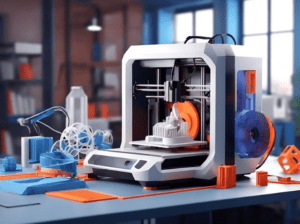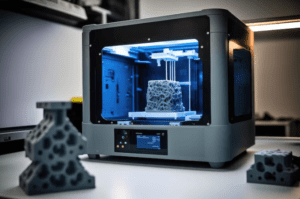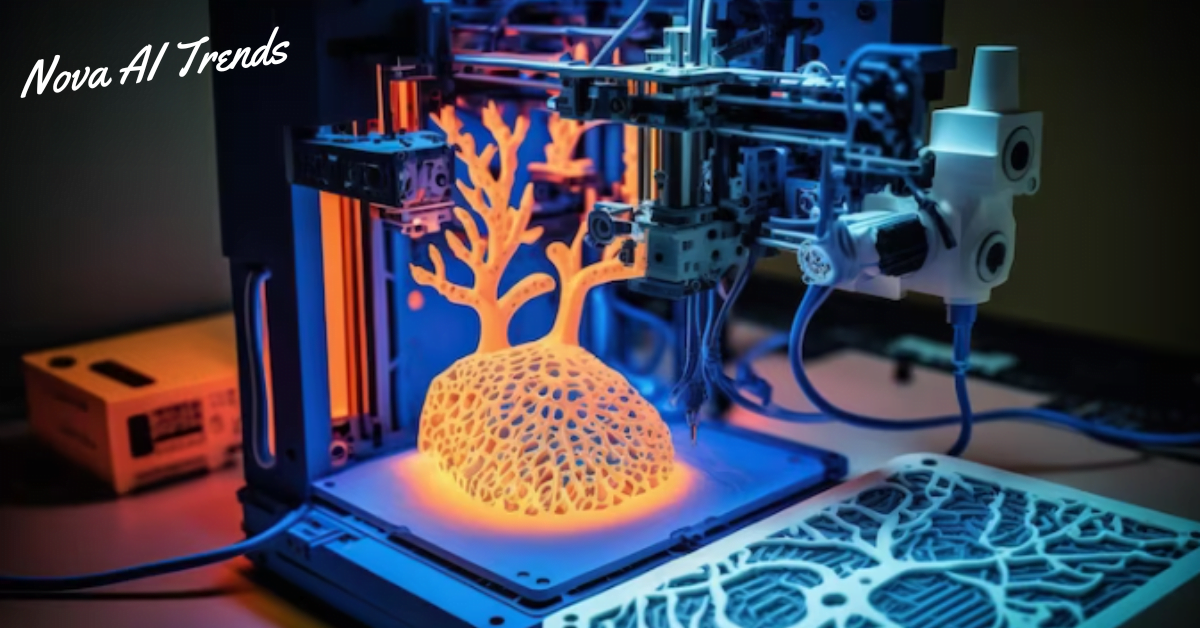AI and 3D Printing: A Revolution in Manufacturing
Introduction
In the ever-evolving realm of technology, the infusion of artificial intelligence (AI) into diverse industries has facilitated pioneering progress. One such sector is 3D printing, which has undergone a remarkable metamorphosis through the integration of AI. AI in the domain of 3D printing transcends mere conceptuality; it emerges as a transformative force that is reshaping the contours of manufacturing and design. This exposition delves into the enthralling interplay between AI and 3D printing, elucidating how it is reconceptualizing the art of object creation, prototyping, and manufacturing.
Table of Contents
ToggleThe Metamorphosis of 3D Printing
 3D printing, otherwise called added substance producing, has navigated an impressive developmental way since its beginning. Its underlying object was dominatingly bound to speedy prototyping, yet throughout the long term, it has found applications in heap areas, including aviation, auto, medical services, and then some. The process entails the incremental construction of three-dimensional entities, employing a spectrum of materials ranging from plastics and metals to ceramics and even biocompatible substances. Traditional 3D printing leans upon computer-aided design (CAD) files for object generation, but AI is poised to elevate this technology to unprecedented pinnacles.
3D printing, otherwise called added substance producing, has navigated an impressive developmental way since its beginning. Its underlying object was dominatingly bound to speedy prototyping, yet throughout the long term, it has found applications in heap areas, including aviation, auto, medical services, and then some. The process entails the incremental construction of three-dimensional entities, employing a spectrum of materials ranging from plastics and metals to ceramics and even biocompatible substances. Traditional 3D printing leans upon computer-aided design (CAD) files for object generation, but AI is poised to elevate this technology to unprecedented pinnacles.
The Fusion of AI and 3D Printing
AI, as an expansive field encompassing machine learning, deep learning, neural networks, and allied techniques, endows machines with the capacity to acquire knowledge from data, make prognostications, and refine their performance over time. When seamlessly integrated into the sphere of 3D printing, AI operates as an orchestrator of enhancements across diverse facets of the process, rendering it more expeditious, efficacious, and cost-efficient.
Optimization of Design
One of the cardinal domains where AI has wrought a substantive impact on 3D printing is design optimization. AI algorithms have the capability to engender intricate and resourceful designs hitherto unattainable by human designers. These designs frequently encompass intricate geometries and structures, which not only diminish material utilization but also augment the operational efficiency of the objects being printed.

To elucidate, AI can meticulously scrutinize the operational prerequisites of an object and devise designs attuned to fulfilling those requirements. This facet proves particularly invaluable in industries such as aerospace and automotive, where components need to exhibit a harmonious balance between lightness and robustness. AI-optimized designs in 3D printing hold the potential to metamorphose the conventional paradigms of object conception and fabrication, culminating in superlative products characterized by both lightness and durability.
Optimization of Printing Paths
The very process of printing can derive substantial advantages from AI’s proficiencies. AI algorithms can discern the most efficient trajectory for the nozzle of the 3D printer, thereby curtailing printing duration and minimizing wastage. By optimizing the printing path, AI concurrently ensures a smoother surface finish for the final object, thereby diminishing the need for post-production refinements.
Material Selection and Quality Oversight
AI assumes a pivotal role in the selection of the most apt materials for specific printing undertakings. This is particularly consequential in sectors like healthcare, where biocompatible materials are paramount. AI algorithms can scrutinize the attributes of assorted materials and elect the one most congruent with the sought-after characteristics of the ultimate product.
Furthermore, AI can exercise a critical function in quality surveillance by real-time monitoring of the printing process. It can discern aberrations such as stratum misalignment or defects and enact immediate modifications. This substantiates the consummation of the final product in alignment with the requisites of quality standards, thereby mitigating the necessity for costly reprints and curbing wastage.
Predictive Maintenance
3D printers, especially those of industrial caliber, constitute substantial financial investments. AI can be harnessed to institute prognosticative maintenance regimes, overseeing the health of the printer and instigating maintenance interventions as exigencies dictate. This proactive approach translates into a diminishment of downtime and an extension of the equipment’s lifespan, ultimately culminating in fiscal savings for manufacturers.
Applications of AI in 3D Printing
The symbiosis of AI and 3D printing unfolds an extensive array of applications across sundry industries. Herein, we delineate some salient instances:
 Healthcare: Within the healthcare domain, AI-empowered 3D printing assumes the mantle of crafting bespoke implants, prosthetics, and medical apparatus. AI can dissect patient-specific data, such as CT scans or MRIs, to conceptualize and manufacture implants that resonate perfectly with individual anatomies. This augments patient outcomes and curtails the prospects of complications.
Healthcare: Within the healthcare domain, AI-empowered 3D printing assumes the mantle of crafting bespoke implants, prosthetics, and medical apparatus. AI can dissect patient-specific data, such as CT scans or MRIs, to conceptualize and manufacture implants that resonate perfectly with individual anatomies. This augments patient outcomes and curtails the prospects of complications.
Aerospace: The aerospace sector leverages AI in 3D printing to engender lightweight yet resilient components for aircraft and spacecraft. AI-optimized designs and sophisticated materials usher in the development of constituents that abide by stringent performance and safety benchmarks, all the while economizing on fuel consumption and curtailing emissions.
Automotive: AI finds application in the design and fabrication of automotive components boasting an elevated strength-to-weight ratio. This eventuates in vehicles characterized by heightened fuel efficiency and reduced emissions. Furthermore, AI is instrumental in expeditious prototyping, facilitating manufacturers in the swift testing and enhancement of designs.
Consumer Goods: The impetus for customization and personalization propels the utilization of AI in 3D printing for consumer merchandise. Be it individualized fashion accessories or unique home decor items, 3D printers under the aegis of AI possess the capability to generate one-of-a-kind commodities attuned to the idiosyncratic preferences of consumers.
Challenges and Future Trajectories
While the infusion of Artificial Intelligence into 3D printing promises bounteous advantages, it is not devoid of concomitant challenges. A selection of issues necessitating resolution encompasses:
I ntellectual Property: With the capacity to engender exquisitely optimized designs, safeguarding intellectual property rights emerges as a salient concern. AI-forged designs may require novel forms of legal safeguarding.
ntellectual Property: With the capacity to engender exquisitely optimized designs, safeguarding intellectual property rights emerges as a salient concern. AI-forged designs may require novel forms of legal safeguarding.
Certification and Regulation: Sectors like aerospace and healthcare impose exacting certification and regulation requisites. The amalgamation of AI into 3D printing processes begets the necessity for novel standards and supervisory mechanisms.
Data Security: AI’s learning process hinges upon extensive datasets, which may encompass confidential information. The concerns of data security and privacy necessitate conscientious addressing as AI’s integration with 3D printing intensifies.
Accessibility: It’s crucial to ensure broad access to AI-enhanced 3D printing to address existing disparities in the manufacturing sector.
Conclusion
Artificial Intelligence in 3D printing combines two groundbreaking advancements, revolutionizing manufacturing and design with unprecedented shape possibilities. Artificial Intelligence and 3D printing have yielded significant advances in healthcare, aerospace, automotive, and consumer goods. It can transform object creation with faster printing and superior quality through design optimization, revolutionizing prototyping and manufacturing.
The advancing Artificial Intelligence and affordable 3D printing will profoundly impact diverse industries. While obstacles proliferate, the degree of advancement and progress stays endless. AI-driven 3D printing has arrived, revolutionizing our perspective on shaping the world.


